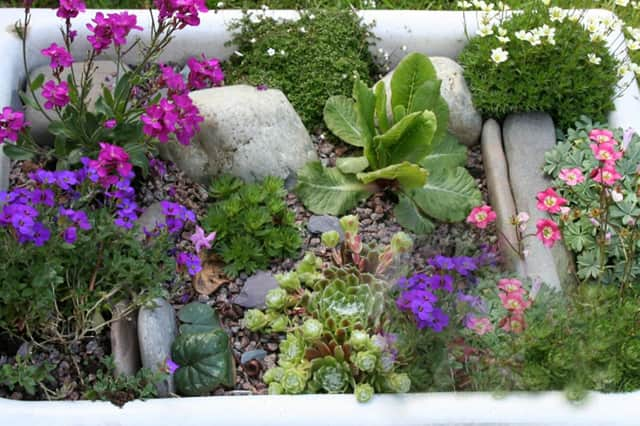How to turn an old sink into an alpine garden '“Â Brian Kidd


Real stone sinks are quite expensive but you may be able to an old Butler sink which could be made to look really interesting with real alpine plants.
But how do you disguise the fact that it's a sink and not a real stone container?
Advertisement
Hide AdAdvertisement
Hide AdWell, the outside of the sink can be coated with a mixture of hypertufa using one part cement powder, one part fine peat and one part sharp sand mixed together with water.
This is applied to the outside and the rim of the sink. Don't worry, it will stick on eventually. Just be patient. Try to attain a natural effect, not a smooth covering. Just like me, it needs to look a bit rugged!
By this time next year it will have weathered and take on the appearance of real stone.
A layer of broken clay flowerpots is put into the place where the plughole is in the base and then the container is filled with John Innes No1 compost. If make sure that 20 per cent of the mixture is sharp sand, you will have the perfect medium for alpine plants.
Advertisement
Hide AdAdvertisement
Hide AdNow fill the sink to within an inch of the top and then we are ready for the planting.
Choose one miniature conifer such as chamaecyparis obtusa Nana Gracilis which is a really good miniature, and plant it on one side of the sink with a nice piece of rock alongside (you can buy pieces of rock at your garden centre).
Cyclamen coum, the eastern sowbread, will flower in February. This has pink, red or white flowers and is only three inches tall. It has marbled leaves nearly all the year and looks great alongside edelweiss.
You will only need five alpine plants for your sink. Have a look at your garden centre to find out what will provide colour or interest throughout the year. It is likely you will find saxifraga, alpine phlox, beautiful gentians, house leeks and even snowdrops, all of which are real alpines.
Advertisement
Hide AdAdvertisement
Hide AdTry not to use/transplant rock garden plants which you have already in the garden as they may be too tall. Instead, choose little gems to give yourself a cultural treat. The sink garden will need watering. Rain water is ideal but feel the compost before watering. With the drainage in the base, it will never become waterlogged.
Finally, during the autumn, after picking off dead foliage, cover the compost's surface with white stone chippings. This looks good and professional and stops mud splashing on to new leaves and flowers which form in the spring.
So what's the difference between a Butler and a Belfast sink? The Butler sink was originally designed for the butler's pantry in London. Back in the day, London had far less readily available water than it does today so it was important to save every drop.Â
Belfast sinks are an adaptation of Butler sinks. In coastal Belfast, where it also rains a lot, water was not scarce, so the Belfast sink, unlike the Butler, had a built-in overflow.
THIS WEEK'S TOP TIP
If you haven't moved your rhubarb for ages do it  now and give each clump a generous amount of farmyard manure. If you need more plants, this is the time to split the clumps.
Â
Â